
Cecil Calvert, 2nd Baron Baltimore, was an English nobleman who was the first Proprietor of the Province of Maryland, ninth Proprietary Governor of the Colony of Newfoundland and second of the colony of Province of Avalon to its southeast. His title was "First Lord Proprietary, Earl Palatine of the Provinces of Maryland and Avalon in America". He received the proprietorship after the death of his father, George Calvert, 1st Baron Baltimore,, for whom it had been intended. Cecil Calvert established and managed the Province of Maryland from his home, Kiplin Hall, in North Yorkshire, England. As an English Roman Catholic, he continued the legacy of his father by promoting religious tolerance in the colony.

Baron Baltimore or Lord Baltimore, of Baltimore Manor in County Longford, was a title in the Peerage of Ireland. It was created in 1625 and ended in 1771, upon the death of its sixth-generation male heir, aged 40.

The Southern Colonies within British America consisted of the Province of Maryland, the Colony of Virginia, the Province of Carolina and the Province of Georgia. In 1763, the newly created colonies of East Florida and West Florida would be added to the Southern Colonies by Great Britain until when the Spanish Empire took back Florida.

The Province of Maryland was an English and later British colony on the continent of North America that existed from 1632 / 1634 until 1776, when it joined the other twelve of the Thirteen Colonies in the American Revolution (rebellion) against Great Britain and became the seventh U.S. state of Maryland. Its first settlement and colonial capital town was St. Mary's City (1634-1695), along the north shore of the Potomac River in the southern end of St. Mary's County, which is a peninsula in the Chesapeake Bay and is also bordered by four tidal rivers.

George Calvert, 1st Baron Baltimore, was an English politician and coloniser. He achieved domestic political success as a member of parliament and later Secretary of State under King James I. He lost much of his political power after his support for a failed marriage alliance between Prince Charles and the Spanish House of Habsburg royal family. Rather than continue in politics, he resigned all of his political offices in 1625 except for his position on the Privy Council and declared his Catholicism publicly. He was created Baron Baltimore in the Peerage of Ireland upon his resignation. Baltimore Manor was located in County Longford, Ireland.
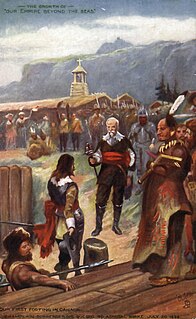
Sir David Kirke, also spelt David Ker, was an adventurer, colonizer and governor for the king of England. He is best known for his successful capture of New France in 1629 during the Thirty Years' War and his subsequent governorship of lands in Newfoundland. A favourite of Charles I of England, Kirke's downfall came with that of the Crown during the English Civil War and it is believed he died in prison.

William Claiborne also, spelled Cleyburne was an English pioneer, surveyor, and an early settler in the colonies/provinces of Virginia and Maryland and around the Chesapeake Bay. Claiborne became a wealthy planter, a trader, and a major figure in the politics of the colonies. He was a central figure in the disputes between the colonists of Virginia and the later settling of Maryland, partly because of his earlier trading post on Kent Island in the mid-way of the Chesapeake Bay, which provoked the first naval military battles in North American waters. Claiborne repeatedly attempted and failed to regain Kent Island from the Maryland Calverts, sometimes by force of arms, after its inclusion in the lands that were granted by a 1632 Royal Charter to the Calvert family (to Sir George Calvert, first Baron and Lord Baltimore,, by the reigning King of England, Charles I,, thus becoming Maryland territory.
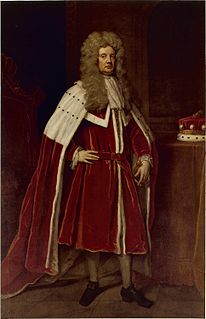
Charles Calvert, 3rd Baron Baltimore, inherited the colony of Maryland in 1675 upon the death of his father, Cecil Calvert, 2nd Baron Baltimore, (1605–1675). He had been his father's Deputy Governor since 1661 when he arrived in the colony at the age of 24. However, Charles left Maryland for England in 1684 and would never return. The events following the Glorious Revolution in England in 1688 would cost Calvert his title to Maryland; in 1689 the royal charter to the colony was withdrawn, leading to direct rule by the British Crown. Calvert's political problems were largely caused by his Roman Catholic faith which was at odds with the established Church of England. Calvert married four times, outliving three wives, and had at least two children. He died in England in 1715 at the age of 78, his family fortunes much diminished. With his death he passed his title, and his claim to Maryland, to his second son Benedict Leonard Calvert, 4th Baron Baltimore (1679–1715), his eldest son Cecil having died young. However, Benedict Calvert would outlive his father by just two months, and It would fall to Charles' grandson, Charles Calvert, 5th Baron Baltimore, (1699–1751), to see the family proprietorship in Maryland restored by the king.
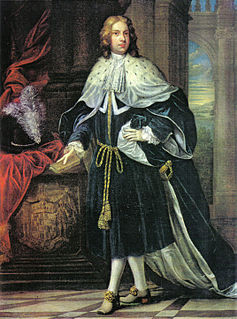
Benedict Leonard Calvert, 4th Baron Baltimore was an English nobleman and politician. He was the second son of Charles Calvert, 3rd Baron Baltimore (1637–1715) by Jane Lowe, and became his father's heir upon the death of his elder brother Cecil in 1681. The 3rd Lord Baltimore was a devout Roman Catholic, and had lost his title to the Province of Maryland shortly after the events of the Glorious Revolution in 1688, which saw the Protestant monarchs William III and Mary II accede to the British throne. Benedict Calvert would make strenuous attempts to have his family's title to Maryland restored by renouncing Roman Catholicism and joining the Church of England.

Charles Calvert, 5th Baron Baltimore, was a British nobleman and Proprietary Governor of the Province of Maryland. He inherited the title to Maryland aged just fifteen, on the death of his father and grandfather, when the colony was restored by the British Monarchy to the Calvert family's control, following its seizure in 1688. In 1721 Charles came of age and assumed personal control of Maryland, travelling there briefly in 1732. For most of his life he remained in England, where he pursued an active career in politics, rising to become Lord of the Admiralty from 1742 to 1744. He died in 1751 in England, aged 52.

Hon. Leonard Calvert was the first proprietary governor of the Province of Maryland. He was the second son of George Calvert, 1st Baron Baltimore (1579–1632), the first proprietor of Maryland. His elder brother Cecil (1605–1675), who inherited the colony and the title upon the death of their father George, April 15, 1632, appointed Leonard as governor of the Colony in his absence. Leonard was named after his grandfather, who was Leonard Calvert of Yorkshire.

Elihu Emory Jackson, a member of the United States Democratic Party, was the 41st Governor of Maryland in the United States from 1888 to 1892. He was born in 1837 in Delmar, Maryland and died in 1907 in the City of Baltimore, Maryland. He is buried at the Parsons Cemetery in Salisbury, Maryland, the county seat of Wicomico County. He was part owner of Pemberton Hall, listed on the National Register of Historic Places in 1971.
A lord proprietor is a person granted a royal charter for the establishment and government of an English colony in the 17th century. The plural of the term is "lords proprietors" or "lords proprietary".

Anne Calvert, Baroness Baltimore was an English noblewoman, daughter of Thomas Arundell, 1st Baron Arundell of Wardour, by his second wife Anne Philipson, and wife of Lord Baltimore, who founded the Province of Maryland colony. Anne Arundel County in the US state of Maryland was named for her. In addition, USS Anne Arundel (AP-76), an American naval transport ship of the Elizabeth C. Stanton-class was in turn named after the county. It served in the United States Navy from 1940 to 1970.

Andrew White was an English Jesuit missionary who was involved in the founding of the Maryland colony. He was a chronicler of the early colony, and his writings are a primary source on the land, the Native Americans of the area, and the Jesuit mission in North America. For his efforts in converting and educating the native population, he is frequently referred to as the "Apostle of Maryland." He is considered a forefather of Georgetown University, and is memorialized in the name of its White-Gravenor building, a central location of offices and classrooms on the university's campus.
Thomas Greene of Bobbing, Kent, 2nd Proprietary Governor of Maryland was an early settler of the Maryland colony and second Provincial Governor of the colony from 1647 to 1648.
Hon. Phillip Calvert, also known as Hon. Philip Calvert, was the fifth Governor of Maryland during a brief period in 1660 or 1661. He was appointed by the royally chartered proprietor of Maryland, Charles Calvert, 3rd Baron Baltimore (1637–1715), as a caretaker to replace Lt. Gen Josias Fendall (1628–1682), the fifth/sixth? provincial governor.

Maryland Dove is a re-creation/replica of Dove, an early 17th-century English trading ship, one of two ships which made up the first expedition from England to the Province of Maryland. The modern Dove was designed by the naval architect and naval historian William A. Baker.
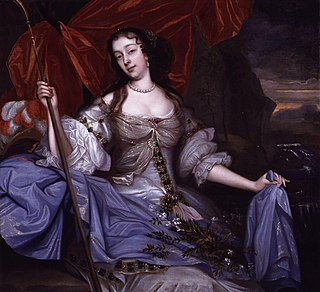
Charlotte Lee, Lady Baltimore, was an English noblewoman, and granddaughter of King Charles II of England and his mistress Barbara Villiers. She married in 1699, Benedict Leonard Calvert, 4th Baron Baltimore, from whom she separated in 1705; she later married Christopher Crowe. She was the mother of Charles Calvert, 5th Baron Baltimore, and of Benedict Leonard Calvert, who was Governor of Maryland from 1727–1731.
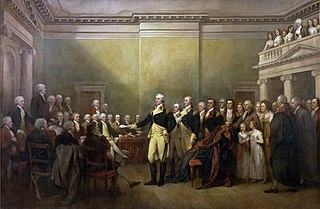
Then Province of Maryland had been a British / English colony since 1632, when Sir George Calvert, first Baron of Baltimore and Lord Baltimore (1579-1632), received a charter and grant from King Charles I of England and first created a haven for English Roman Catholics in the New World, with his son, Cecilius Calvert (1605-1675), the second Lord Baltimore equipping and sending over the first colonists to the Chesapeake Bay region in March 1634. The first signs of rebellion against the mother country occurred in 1765, when the tax collector Zachariah Hood was injured while landing at the second provincial capital of Annapolis docks, arguably the first violent resistance to British taxation in the colonies. After a decade of bitter argument and internal discord, Maryland declared itself a sovereign state in 1776. The province was one of the Thirteen Colonies of British America to declare independence from Great Britain and joined the others in signing a collective Declaration of Independence that summer in the Second Continental Congress in nearby Philadelphia. Samuel Chase, William Paca, Thomas Stone, and Charles Carroll of Carrollton signed on Maryland's behalf.
















